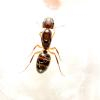- Formiculture.com
- Forums
- Gallery
- Members
- Member Map
- Chat

D. melanogaster or D. hydei?
Started By
Nathant2131
, Jun 22 2017 11:37 AM
19 replies to this topic
#1
 Offline
-
Posted June 22 2017 - 11:37 AM
Offline
-
Posted June 22 2017 - 11:37 AM
Was wondering what fruit fly species would be better for ants. Any differences in nutrition? What species do you guys use?
#2
 Offline
-
Posted June 22 2017 - 11:55 AM
Offline
-
Posted June 22 2017 - 11:55 AM
I've used both with pretty good success for species that like fruit flies. D. hydei are larger and less jumpy, so I would think most people would generally prefer that species. In either case, I usually chill them in the fridge for about ten minutes prior to feeding so they're easier targets.
#3
 Offline
-
Posted June 22 2017 - 12:16 PM
Offline
-
Posted June 22 2017 - 12:16 PM
For most purposes, you'll want D. hydei. They're twice, maybe three times the size of mels which means you can feed less individual flies per meal. They produce less numbers and are slightly more sensitive and slower to culture.
If you need lots of fruit flies and fast, D. melanogaster can't be beat. They work well for most colonies past the founding stage of species who will accept them, and can fulfill much of the protein requirements of a proper diet.
Wingless beats flightless and is the mutation you want. Flightless flies can jump well and may even revert back to flying in high temperatures, and their nutrition-less wings simply add to the trash pile.
If you need lots of fruit flies and fast, D. melanogaster can't be beat. They work well for most colonies past the founding stage of species who will accept them, and can fulfill much of the protein requirements of a proper diet.
Wingless beats flightless and is the mutation you want. Flightless flies can jump well and may even revert back to flying in high temperatures, and their nutrition-less wings simply add to the trash pile.
Edited by 123LordOfAnts123, June 22 2017 - 12:18 PM.
#4
 Offline
-
Posted June 22 2017 - 1:03 PM
Offline
-
Posted June 22 2017 - 1:03 PM
I am not planning to culture them, only to buy them dead at a pet store or something. Thanks for the help!
#5
 Offline
-
Posted June 22 2017 - 1:14 PM
Offline
-
Posted June 22 2017 - 1:14 PM
When you buy them at a pet store, you'll be buying a live culture in a jar or other container. Most of them will likely still be larvae. It's usually somewhere around $4-8 for a premade culture jar and will yield 5-10 generational pulses before the culture medium is used up. If you want to get your money's worth, you'll want to culture them until the jar is used up, otherwise it isn't really an economical food option. For even more value, you can buy a couple mason jars and get some culture mix from a company like Josh's Frogs and keep the culture going long after the initial purchase.
- Nathant2131 likes this
#6
 Offline
-
Posted June 22 2017 - 1:20 PM
Offline
-
Posted June 22 2017 - 1:20 PM
I've found that melanogaster is accepted by most species, especially Camponotus, Myrmica and Lasius.
- Nathant2131 likes this
#7
 Offline
-
Posted June 22 2017 - 3:06 PM
Offline
-
Posted June 22 2017 - 3:06 PM
If you're not planning on culturing them, why not just buy some crickets and keep them in the freezer? If you do buy the smaller crickets.
#8
 Offline
-
Posted June 22 2017 - 3:54 PM
Offline
-
Posted June 22 2017 - 3:54 PM
I ended up getting a vial of live flightless D. hydei from petsmart. Cameron was right, 95% of them are larvae. I wonder how I'm going to get only one or two flies without letting all of them escape.
#9
 Offline
-
Posted June 22 2017 - 4:21 PM
Offline
-
Posted June 22 2017 - 4:21 PM
I ended up getting a vial of live flightless D. hydei from petsmart. Cameron was right, 95% of them are larvae. I wonder how I'm going to get only one or two flies without letting all of them escape.
Chill them for about ten minutes in the fridge to slow them down. When you pull them out, tap bottom of the vial on the table to knock them all to the bottom of the vial. Then, quickly, remove the foam at the top, tip the open end of the vial over the outworld, and give the raised bottom a couple taps to knock out the desired amount of flies.
Don't worry about the medium coming out. It's good and stuck in there.
Another thing, don't toss out all the adults at once. You'll want some in there to continue mating and laying eggs.
Edited by Cameron C. Thomas, June 22 2017 - 4:23 PM.
- Nathant2131 likes this
#10
 Offline
-
Posted June 22 2017 - 4:33 PM
Offline
-
Posted June 22 2017 - 4:33 PM
I ended up getting a vial of live flightless D. hydei from petsmart. Cameron was right, 95% of them are larvae. I wonder how I'm going to get only one or two flies without letting all of them escape.
Chill them for about ten minutes in the fridge to slow them down. When you pull them out, tap bottom of the vial on the table to knock them all to the bottom of the vial. Then, quickly, remove the foam at the top, tip the open end of the vial over the outworld, and give the raised bottom a couple taps to knock out the desired amount of flies.
Don't worry about the medium coming out. It's good and stuck in there.
Another thing, don't toss out all the adults at once. You'll want some in there to continue mating and laying eggs.
Ok, thanks very much for the help!
- Cameron C. Thomas likes this
#11
 Offline
-
Posted June 22 2017 - 4:35 PM
Offline
-
Posted June 22 2017 - 4:35 PM
I recommend melanogaster. HydeI reproduce extremely slowly. I have both species and although the hydei are larger, the melanogaster produce more body mass and will produce flies within a week
- Nathant2131 likes this
Visit us at www.canada-ant-colony.com !
#12
 Offline
-
Posted June 22 2017 - 4:44 PM
Offline
-
Posted June 22 2017 - 4:44 PM
I recommend melanogaster. HydeI reproduce extremely slowly. I have both species and although the hydei are larger, the melanogaster produce more body mass and will produce flies within a week
Yeah, the brief care sheet that came with the flies said that D. hydei were a lot slower, but I'm in no rush. My ant colonies are pretty small at the moment. The D. hydei flies are really small so I can't imagine how small D. melanogaster are.
As I get more experienced in the hobby I'll try out both species sometime.
Edited by Nathant2131, June 22 2017 - 4:45 PM.
#13
 Offline
-
Posted June 24 2017 - 2:00 PM
Offline
-
Posted June 24 2017 - 2:00 PM
D. hydei works for me but I suppose that D. melanogaster would work too...
Proverbs 6:6-8 New International Version (NIV)
6 Go to the ant, you sluggard;
consider its ways and be wise!
7 It has no commander,
no overseer or ruler,
8 yet it stores its provisions in summer
and gathers its food at harvest.
#14
 Offline
-
Posted June 24 2017 - 2:43 PM
Offline
-
Posted June 24 2017 - 2:43 PM
The D. hydei flies are really small so I can't imagine how small D. melanogaster are.
They are tiny, but so are a lot of ants. My Tapinoma damn near have to tag team one to take it down, and some ants get significantly smaller. On the flip side, they're still plenty large enough to be hunted by relative giants like C. pennsylvanicus. Just for simplicity's sake, I'd recommend anyone start with D. melanogaster. They're a lot harder to mess up.
Oh, and fyi, Cameron name dropped Josh's Frogs. You can make your own media for pennies, so I've always considered Josh's Frogs' media a waste of money. Then I ordered a culture of flies from them, and their media easily let the culture stay viable a month or so longer than my amateurish potato flake recipe. I'm still not sure if it's worth the money, but don't ever think it's not great stuff. Just make sure to look into mite paper if you're wanting to set up things long term.
Edited by Antsinmycloset, June 24 2017 - 2:45 PM.
- Nathant2131 likes this
#15
 Offline
-
Posted June 24 2017 - 3:32 PM
Offline
-
Posted June 24 2017 - 3:32 PM
I had a test tube full of D. melanogaster in my freezer that has lasted over 2 years. I used a funnel to dump the producing culture into the tube before plugging and freezing it. Can't go wrong this way, whichever species you get.
- Nathant2131 likes this
byFormica® is the manufacturer of the iconic nectar feeders and Sunburst Ant Nectar.
byFormica ant products always deliver consistent performance, convenience,
and reliability, making them among the most beloved ant foods and kit enjoyed by
ant keeping enthusiasts worldwide. For more information, visit www.byFormica.com.
#16
 Offline
-
Posted June 24 2017 - 4:15 PM
Offline
-
Posted June 24 2017 - 4:15 PM
I had a test tube full of D. melanogaster in my freezer that has lasted over 2 years. I used a funnel to dump the producing culture into the tube before plugging and freezing it. Can't go wrong this way, whichever species you get.
This is an excellent suggestion. I recommend trying this and seeing if it works well for your ants. I've had colonies in the past that were finicky about accepting dead insects vs. living ones, but if your colony is fine with frozen ones, which is the case most of the time, this would be a much better way of storing and using your flies.
- Nathant2131 likes this
#17
 Offline
-
Posted June 24 2017 - 4:32 PM
Offline
-
Posted June 24 2017 - 4:32 PM
So, the larvae and pupae will also survive if I fridge them for around 10 mins, right? Thanks for all the help. I was thinking of storing the flies in the freezer as well, that way they'll last.
Edited by Nathant2131, June 24 2017 - 4:36 PM.
#18
 Offline
-
Posted June 24 2017 - 4:43 PM
Offline
-
Posted June 24 2017 - 4:43 PM
So, the larvae and pupae will also survive if I fridge them for around 10 mins, right? Thanks for all the help. I was thinking of storing the flies in the freezer as well, that way they'll last.
Oh yeah. In fact, my D. melanogaster cultures grow faster than I use them, so I keep them in a fridge at 10 °C to slow their development. They still produce, just much slower, and I'll leave it out for a few days if I need to speed things up. I don't know that I'd keep them at a lower temperature than that, though.
#19
 Offline
-
Posted June 24 2017 - 4:51 PM
Offline
-
Posted June 24 2017 - 4:51 PM
Wow, that's neat how they still thrive . Some hardy little buggers
So, the larvae and pupae will also survive if I fridge them for around 10 mins, right? Thanks for all the help. I was thinking of storing the flies in the freezer as well, that way they'll last.
Oh yeah. In fact, my D. melanogaster cultures grow faster than I use them, so I keep them in a fridge at 10 °C to slow their development. They still produce, just much slower, and I'll leave it out for a few days if I need to speed things up. I don't know that I'd keep them at a lower temperature than that, though.
#20
 Offline
-
Posted June 24 2017 - 5:26 PM
Offline
-
Posted June 24 2017 - 5:26 PM
Here's what the culture looks like:

2 flies, 25-35 larvae, and hundreds of larvae cururently reside in the culture. I feel like there were a few more flies when I first got it (closer to 5-10), but I guess I'm going crazy or they died for whatever reason during their trip home.
Edited by Nathant2131, June 24 2017 - 5:27 PM.
1 user(s) are reading this topic
0 members, 1 guests, 0 anonymous users



















